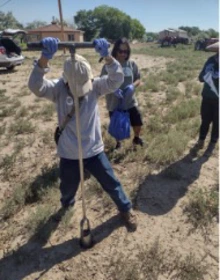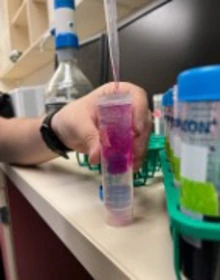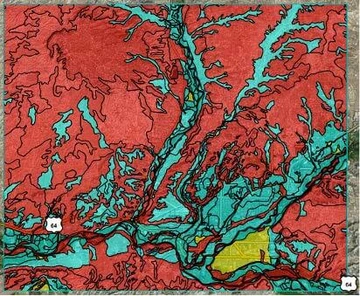
Figure 1. The range comprising most of the sample sites. The red portions of the map indicate areas not considered prime farmland due to inherent soil properties, while the teal portions indicate farmlands of statewide importance if warm enough and protected from flooding, and the yellow portions indicate farmland of statewide importance if well drained. Map generated by Web Soil Survey (https://
websoilsurvey.nrcs.usda.gov/app/, accessed Jul 31, 2025).
Map generated by Web Soil Survey (accessed July 31, 2025)
Understanding the soil health status of agricultural lands is crucial when adopting effective strategies to boost crop productivity. Local growers have shown a desire to understand more about the health status of the soils they work with, though access to assessment resources is limited. In the southwestern U.S., soil health reports are scant, and data are scarce. The National Science Foundation has funded a project to support communities in the U.S. Intermountain West region, and a soil health study was designed to provide the knowledge desired by communities in the region, as well as contribute to the accumulation of soil health data that can support local stakeholders. A total of 64 samples were collected from home gardens and community farms and were tested for a suite of physical, chemical, and biological soil properties. Data suggest that on average, soil health status in and on these gardens and farms are similar to or better than the baselines previously established for Yuma, Arizona, and some of the farmland may benefit from cover cropping or applications of amendments like biochar or compost.
In the Four Corners region (southeastern corner of Utah, southwestern corner of Colorado, northwestern corner of New Mexico, and northeastern corner of Arizona), communities are seeking opportunities to grow healthy food, and many members of the community are thinking of farming their lands. The soils to be used are often virgin, eroded soils that must undergo some remediation before they can become sustainable and productive (Figure 1). Similar systems are growing in many parts of Arizona, as many communities are attempting to be self-sufficient and provide access to fresh, healthy foods. Because of these similarities, recommendations for improving soil health in the soils of the Four Corners region can also be applicable to growers throughout much of Arizona. The University of Arizona has partnered with New Mexico State University to measure soil health and provide guidance on steps to be taken to ensure adequate soil health that can support these communities.
Good soil health is essential for food and agricultural sustainability in U.S. agricultural systems. The United States Department of Agriculture (USDA), Natural Resources Conservation Service (NRCS) recognized the need for monitoring soil health in agricultural operations and developed guidelines for assessment (NRCS, accessed Aug 5, 2025). Currently, soil health data are lacking from arable agricultural lands in the U.S. Intermountain West (IMW), though farmers have shown interest in learning more about their soil and soil health (Sanyal et al., 2023a).
Not only can it be difficult to locate a local analytical laboratory to test soil health parameters, but it is also particularly expensive to do so. The inaccessibility of soil analysis is especially prominent in smaller and less-affluent communities, which are more likely to have reduced access to high quality foods (Ploeg, 2010).
The primary aim of this study was to provide farming communities with soil health information, allowing local growers to be able to make informed decisions that serve community members and a sustainable ecosystem. In this study, a baseline of soil health parameters was determined.
Sample site profiles
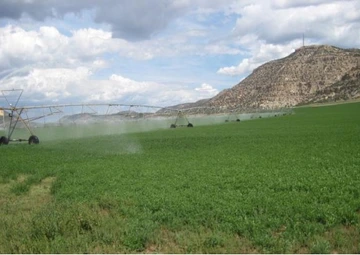
Figure 2. One of the surveyed alfalfa field sites in the Farmington, NM region. The
field is intended to continue growing alfalfa in future years
Brandon Francis, New Mexico State University
Sample locations comprised local home gardens and community farms growing a multitude of different crops. Specifically, approximately half of the surveyed sites were in the process of producing alfalfa (Figure 2), while the remaining half comprised family farms used (or are anticipated to be used) for the production of vegetable crops, as well as several that are used to grow pollinator crops in between panels in a community’s agrivoltaics installation. These farms and gardens do not strictly adhere to organic farming guidelines. The survey primarily consisted of measuring soil health indicators that are indicative of biological production. Specific location information has not been provided to protect landowners’ privacy. However, these landowners will receive specialized report from our team with suggestions and recommendations.
There are some prevalent soil properties that may explain some of the findings from the survey. These data provide a framework for assessing the sample sites in relation to the surrounding area. The additional properties that were gathered via Web Soil Survey (Soil Survey Staff, accessed 31 July, 2025) include properties that influence the growth and function of plants. Local soils appear to have an average bulk density of 1.42 g cm3, surface textures ranging from clay loam to very stony loam (averaging 20% clay, 27% silt, and 55% sand), and parent material predominantly consisting of alluvium or eolian deposits. In addition, their available water holding capacities for the top 0-6 inches (0-15 cm) of the soil profile average 0.13 cm of water per cm of dry soil, with average drainage classes ranging from well drained to somewhat excessively drained.
Description of soil health indicators
Several soil health indicators (SHIs) were assessed to establish the baseline soil health information in the region. These SHIs are soil properties or parameters that were selected based on their status as key soil health and quality indicators by the USDA Natural Resource Conservation Service (NRCS, n.d.). The assessment included soil pH, soil soluble salts or electrical conductivity (EC), permanganate oxidizable carbon (POx-C; reactive carbon), soil respiration, potentially mineralizable nitrogen (PMN), soil protein, wet aggregate stability (WAS), and ß-glucosidase.
Soil pH
Soil pH is a measure of the acidity or alkalinity of the soil. Alkaline indicates a higher pH, which means more alkaline substances (like salts) are present in the soil. The more acidic a soil is, the lower the pH. The soils in the Desert Southwest tend to be more alkaline due to limited rainfall and organic matter (NRCS, 2011b). Soil EC is a measure of the amount of electricity the soil conducts and is used to measure the amounts of total salts within the soil. There are a few factors impacting soil EC, including texture, porosity, and temperature (NRCS, 2011a).
Permanganate-oxidizable carbon
Permanganate-oxidizable carbon is the soil health indicator that is most likely to change quickly based on management practices. It represents the fraction of active carbon in the soil, which is the preferred source of food for most soil bacteria and fungi; it is one of the SHIs most readily impacted by management practices (NRCS, 2014b). Soil respiration is a measurement of microbial activity. As we humans breathe heavier as we exert ourselves doing strenuous activities, soil bacteria and fungi do as well. This “exhaled”, or mineralized carbon is released as carbon dioxide, which can be measured over time to see just how much activity the microbes are doing in the soil (NRCS, 2009).
Potentially mineralizable nitrogen
Potentially mineralizable nitrogen is a measurement of the nitrogen in the soil that is available to be mineralized, or transformed, into plant-available forms. Since this type of compound containing nitrogen can become a plant available type of nitrogen given the exposure to the right soil conditions and soil bacteria and fungi, it is a good measurement of important nitrogen dynamics within the soil (NRCS, 2014a). Proteins are present in the soil as part of the organic matter fraction, as these are produced by cells to perform actions like helping cells eat or reproduce. Because proteins are made up of amino acids which tend to have a sizeable amount of nitrogen, measuring soil protein is a way to determine how much organic nitrogen exists in the soil (Naasko et al., 2024).
These aggregates are held together by slight electrical charges of the particles that may bond them together or may also be held together mechanically by fibrous roots or fungal hyphae (NRCS, 2008). This SHI determines the soil’s ability to resist degradation. ß-glucosidase is an enzyme that is present in the soil. This enzyme aids in the breakdown of complex forms of carbon, cleaving glucose from glucoside (NRCS, 2010). Having substantial concentrations of this enzyme is important both for carbon cycling, but also for the cycling of other nutrients.
Sample collection and analysis
Sixty-four samples were collected from sites around the Farmington, NM region included farms and gardens producing food and forage crops for families and the communities around them. Samples were collected from the top 15 cm of soil profile at five to fifteen random locations within each field, depending on field acreage. The samples were then placed into a five-gallon bucket and aggregated into one sample per farm field site for lab analysis. The samples were then packaged and sent to the University of Arizona’s Maricopa Agricultural Center for processing and analysis. A soil health analysis for the select SHI’s of interest was performed. The SHI’s investigated are known to be indicators of biological activity and production and thus are used to define the suitability of the soil to produce crops. The experiments used for analysis of individual parameters were derived from the Cornell Comprehensive Assessment of Soil Health protocols (Moebius-Clune et al., 2016). PMN, POx-C, soil protein, and ß-glucosidase enzymatic activities were measured following protocols described in Graham et al. (2021), while for WAS, the protocol from Angulo et al. (2024) was used. Data were then analyzed in a spreadsheet program and means and standard deviations for each parameter measured in the region were calculated.
Results and discussion
Soil health assessment results are presented as mean and standard deviation (St. Dev.) values in Table 1. The average values for each SHI align with expectations for arid soils, as they tend to be lower in labile carbon fractions. POx-C, enzyme activity, and WAS values also agree with reported soil health data from other parts of New Mexico (Idowu & Kircher, 2016; Idowu et al., 2017; Acharya et al., 2024). These are characteristics typical of soils in the arid southwest and align with some of the values recorded from previous Arizona soil health surveys, like those detailed in a previous Yuma, Arizona soil health survey in Sanyal et al. (2023b).
Averages and ranges of SHIs from Yuma, AZ and Farmington, NM
| Soil Health Indicator | Arizona Min | Arizona Max | Arizona Mean | New Mexico Min | New Mexico Max | New Mexico Average (St. Dev.) | What’s Better in Your Soil |
|---|---|---|---|---|---|---|---|
| Soil pH | 7.8 | 8.81 | 8.3 | 7.1 | 9.33 | 7.87 | Less |
| Soil EC (µS/cm) | NA | NA | NA | 159 | 828 | 495 | Less |
| POx-C (mg/kg soil) | 28 | 412 | 278 | 135 | 1120 | 601 | More |
| Soil Respiration (mg CO2/g soil/4 days) | 0.1 | 1.28 | 0.5 | 0 | 4.41 | 1.26 | More |
| PMN (ppm NH4) | 0 | 17.9 | 4 | 1.77 | 22.6 | 11 | More |
| ACE Protein (g/kg soil) | 0.5 | 1.36 | 0.9 | 1.43 | 6.69 | 3.77 | More |
| WAS (Stability Value) | 0 | 0.79 | 0.28 | 0.04 | 0.53 | 0.27 | More |
| ß-Glucosidase (mg/L pNG/g soil) | NA | NA | NA | 20 | 330 | 118 | More |
Comparative Data
A study by Sanyal et al. (2023b) was conducted on soils from Yuma, AZ. The soil samples that were analyzed were from fields that landowners and managers reported were productive. As regional (U.S. Southwestern) soil health data are scarce, these Yuma data provide a comparative baseline to establish how suitable the NM soils may be for the production of similar vegetable and forage crops.
The values for the NM soils showed relatively higher concentrations of labile carbon sources; this is illustrated by a higher mean POx-C concentration in NM (difference of 323 mg/kg soil), a higher mean respiration rate (difference of 0.76 mg CO2/g soil/4 days), a higher mean PMN concentration (difference of 7 ppm), and a higher mean ACE protein concentration (difference of 2.87 g/kg soil). These factors indicate more microbial activity and potential microbial activity in the soil, as the microbes are able to metabolize the ample POx-C and release CO2 via respiration. A more neutral pH in NM soils (difference of 0.44) could possibly be due to differences in evapotranspiration processes, though more data from Yuma like soil EC would be necessary to make any meaningful comparisons. The measured stability values for WAS had a negligible difference.
Treatment recommendations
The average soil pH on these surveyed sites was slightly alkaline, however, a relatively high pH (above 8.2) was recorded in several sites, which may require some sulfurbased amendments like gypsum or elemental sulfur followed by leaching with water. All SHI mean values are on par or higher than the majority of the reported global values (Clark et al., 2019; Graham et al., 2021; Jones et al., 2023; Naasco et al., 2024). However, several survey sites, especially those that are not currently under active farming, showed low values for SHIs, and may need some amelioration before farming can begin. Currently, data suggest that landowners should test their soils to calculate gypsum and leaching requirements. Grass cover crop species may be particularly effective in the repairing of soil health (Arp et al., 2024; Sanyal et al., 2025). Further studies should be conducted to prescribe more specific recommendations.
Conclusion
This study contributes to the growing understanding of soil health in the arid soils of the U.S. Desert Southwest. Factors such as organic matter content are vital to the production of crops which may be vital to sustaining the communities around which the lands are located. Because of this, management practices like cover cropping or treatment with sulfur can be useful in improving chemical and organic soil properties. Further research should include a greater range of soil physicochemical properties, including soil salinity and sodicity (relative proportion of sodium ions), key nutrient concentrations, and different forms of carbon and nitrogen to obtain a full understanding of soil health in the region. Continued sampling and analyses should be performed to understand the maintenance requirements of the health of the soils as they are used to cultivate produce. In doing so, it can be assured that these lands will continue to be sustained and productive in the future. Additional research investments should look into potential soil health improvement strategies for both new and existing agricultural operations. Practices like cover cropping, composting, or mulch application to improve soil health should also be further investigated in arid agroenvironments of the southern Intermountain West
Both universities involved in this study are working on their Land Grant mission of educating the communities through extension and outreach activities. More events are needed to educate the producers and potential producers on soil health management and sustainable agricultural practices. The UA team presented soil health information to local communities during the 2023 Farmington Fair (Figure 4), and intend to continue participating in community outreach initiatives to disseminate helpful information.
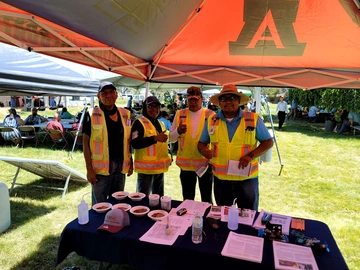
Figure 4. Community engagement efforts continue to inform the stakeholders of soil health and their own soil health data. The University of Arizona’s collaborative work in the Farmington, NM region continues to support local communities.
Debankur Sanyal, Cooperative Extension
Acknowledgment
This research was funded by the National Science Foundation Grant #2115169, SRS RN: Transforming Rural-Urban Systems: Trajectories for Sustainability in the Intermountain West.
References
Acharya, P., Ghimire, R., & Acosta-Martínez, V. (2024). Cover crop-mediated soil carbon storage and soil health in semi-arid irrigated cropping systems. Agriculture, Ecosystems & Environment, 361, 108813. https://doi.org/10.1016/j.agee.2023.108813
Angulo, V., Bleichrodt, R. J., Dijksterhuis, J., Erktan, A., Hefting, M. M., Kraak, B., & Kowalchuk, G. A. (2024). Enhancement of soil aggregation and physical properties through fungal amendments under varying moisture conditions. Environmental microbiology, 26(5), e16627. https://doi.org/10.1111/1462-2920.16627
Arp, T., Stackpole, C., & Sanyal, D. (2024). Cover Crops and Carbon Sequestration: A Perspective for Desert Soils. University of Arizona Cooperative Extension Publication number: az2084-2024. https://extension.arizona.edu/publication/cover-crops-and-carbonsequestration-perspective-desert-soils
Clark, J. D., Veum, K. S., Fernandez, F. G., Camberato, J. J., Carter, P. R., Ferguson, R. B., ... & Shanahan, J. F. (2019). United States Midwest soil and weather conditions influence anaerobic potentially mineralizable nitrogen. Soil Science Society of America Journal, 83(4), 1137-1147. https://doi.org/10.2136/sssaj2019.02.0047
Graham, C., van Es, H., & Sanyal, D. (2021). Soil health changes from grassland to row crops conversion on Natric Aridisols in South Dakota, USA. Geoderma Regional, 26, e00425. https://doi.org/10.1016/j.geodrs.2021.e00425
Idowu, O. J., & Kircher, P. (2016). Soil quality of semi-arid conservation reserve program lands in Eastern New Mexico. Arid Land Research and Management, 30(2), 153- 165. https://doi.org/10.1080/15324982.2015.1065932
Idowu, O. J., Sanogo, S., & Brewer, C. E. (2017). Short-term impacts of pecan waste by-products on soil quality in texturally different arid soils. Communications in Soil Science and Plant Analysis, 48(15), 1781-1791. https://doi.org/10.1080/00103624.2017.1395448
Jones, E. J., Hong, Y., Pino, V., Pauly, V., Singh, K., Field, D., & McBratney, A. B. (2023). Optimising POXC effective sensitivity as a soil indicator in Australian soils. Soil Security, 13, Article 100116. https://doi.org/10.1016/j.soisec.2023.100116
Moebius-Clune, B. N., Moebius-Clune, D. J., Gugino, B. K., Idowu, O. J., Schindelbeck, R. R., Ristow, A. J., van Es, H. M., Thies, J. E., Shayler, H. A., McBride, M. B., Kurtz, K. S. M., Wolfe, D. W., & Abawi, G. S. (2016). Comprehensive Assessment of Soil Health – The Cornell Framework, Edition 3.2, Cornell University, Geneva, NY. Mosaic. Soil pH. https://www.cropnutrition.com/nutrient-management/soil-ph/:~:text=Rainf… become%20acidic. Accessed September 7, 2025
Naasko, K., Martin, T., Mammana, C., Murray, J., Mann, M., & Sprunger, C. (2024). Soil protein: A key indicator of soil health and nitrogen management. Soil Science Society of America Journal, 88(1), 89–108. https://doi.org/10.1002/saj2.20600
NRCS. (2008). Soil Quality Indicators: Aggregate Stability. https://www.nrcs.usda.gov/sites/default/files/2022-10/nrcs142p2_051276.pdf
NRCS. (2009). Soil Quality Indicators: Soil Respiration. https://www.nrcs.usda.gov/sites/default/files/2022-10/soil_respiration.pdf
NRCS. (2010). Soil Quality Indicators: Soil Enzymes. https://www.nrcs.usda.gov/sites/default/files/2023-01/Soil%20Quality-Soil%20Enzymes.pdf
NRCS. (2011a). Soil Quality Indicators: Soil Electrical Conductivity. https://www.nrcs.usda.gov/sites/default/files/2022-10/Soil%20Electrical%20Conductivity.pdf
NRCS. (2011b). Soil Quality Indicators: Soil pH. https://www.nrcs.usda.gov/sites/default/files/2022-10/soil_ph.pdf
NRCS. (2014a). Soil Quality Indicators: Potentially Mineralizable Nitrogen (PMN). https://www.nrcs.usda.gov/sites/default/files/2022-10/potentially_mineralizable_nitrogen.pdf
NRCS. (2014b). Soil Quality Indicators: Reactive Carbon. https://www.nrcs.usda.gov/sites/default/ files/2022-10/reactive_carbon.pdf
NRCS. Soil Health Assessment. https://www.nrcs.usda.gov/conservation-basics/natural-resource-concerns/soils/soil-health/soil-health-assessment. Accessed August 5, 2025.
Ploeg, M. V. (2010, 1 March). Access to Affordable, Nutritious Food is Limited in “Food Deserts.” Amber Waves. https://www.ers.usda.gov/amber-waves/2010/march/access-to-affordable-nu… in%20the%20United,food%20for%20active%2C%20 healthy%20livin.
Sanyal, D., & Arp, T. (2025). The Basics to Winter Cover Crop Considerations for Arizona Growers. University of Arizona Cooperative Extension Publication number: az2111-202. https://extension.arizona.edu/publication/basicswinter-cover-crop-considerations-arizona-growers
Sanyal, D., Masson, R., Stackpole, C., & Arp, T. (2023a). A Soil Health Needs Assessment Survey in Arizona. University of Arizona Cooperative Extension Publication number: az2067-2023. https://repository.arizona.edu/handle/10150/671220
Sanyal, D., Stackpole, C., & Masson, R. (2023b). A Comprehensive Soil Health Survey and Assessment in Yuma: Final Report. Desert Ag Solutions. https://desertagsolutions.org/sites/default/files/YSHS_Final%20Report_S… al.%202023_0.pdf
Soil Survey Staff. Web Soil Survey. USDA NRCS. http://websoilsurvey.sc.egov.usda.gov/. Accessed 31 July, 2025.


